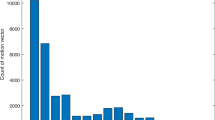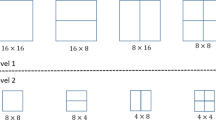Abstract
This paper presents an effective methodology for motion vector-based video steganography. The main principle is to design a suitable distortion function expressing the embedding impact on motion vectors by exploiting the spatial-temporal correlation based on the framework of minimal-distortion steganography. Two factors are considered in the proposed distortion function, which are the statistical distribution change (SDC) of motion vectors in spatial-temporal domain and the prediction error change (PEC) caused by modifying the motion vectors. The practical embedding algorithm is implemented using syndrome-trellis codes (STCs). Experimental results show that the proposed method can enhance the security performance significantly compared with other existing motion vector-based video steganographic approaches, while obtaining the higher video coding quality as well.









Similar content being viewed by others
Notes
1 The video sequence can be a series of raw images or a series of decompressed images obtaining from the coded bit stream.
References
Aly H (2011) Data hiding in motion vectors of compressed video based on their associated prediction error. IEEE Trans Inf Forensic Secur 6 (1):14–18
Bellifemine F, Capellino A, Chimienti A et al (1992) Statistical analysis of the 2D-DCT coefficients of the differential signal for images. Signal Process Image Commun 4 (6):477–488
Cao Y, Zhao X, Feng D, Sheng R (2011) Video steganography with perturbed motion estimation. In: Proceedings of 13th international workshop information hiding, lecture notes in computer science, vol 6958, pp 193–207
Cao Y, Zhao X, Feng D (2012) Video steganalysis exploiting motion vector reversion-based features. IEEE Signal Process Lett 19 (1):35–38
Crandall R (1998) Some notes on steganography. Steganography mailing list. http://os.inf.tu-dresden.de/westfeld/crandall
Fang D-Y, Chang L-W (2006) Data hiding for digital video with phase of motion vector. In: Proceedings of international symposium circuits and systems (ISCAS), pp 1422–1425
Filler T, Fridrich J (2010) Gibbs construction in steganography. IEEE Trans Inf Forensic Secur 5 (4):705–720
Filler T, Judas J, Fridrich J (2010) Minimizing embedding impact in steganography using trellis-coded quantization. In: Proceedings of SPIE, media forensics and security II, vol 7541, pp 05-01–05-14
Filler T, Fridrich J (2011) Design of adaptive steganographic schemes for digital images. In: Proceedings of SPIE, media watermarking, security and forensics III, vol 7880, pp 0F-01–0F-14
Filler T, Judas J, Fridrich J (2011) Minimizing additive distortion in steganography using syndrome-trellis codes. IEEE Trans Inf Forensic Secur 6 (3):920–934
Filler T, Judas J, Fridrich J Syndrome-trellis codes toolbox, ver. 1.0, http://dde.binghamton.edu/download/syndrome/
Fridrich J, Goljan M, Lisonekm P, Soukal D (2005) Writing on wet paper. IEEE Trans Signal Process 53 (10):3923–3935
Gormish MJ, Gill JT (1993) Computation-rate-distortion in transform coders for image compression. SPIE Vis Commun Image Process:146–152
Guo L, Ni J, Shi YQ (2012) An efficient JPEG steganographic scheme using uniform embedding. In: Proceedings of international workshop infornamtion forensics security (WIFS), pp 169–174
Holub V, Fridrich J (2012) Designing steganographic distortion using directional filters. In: Proceedings of international workshop information forensics security (WIFS), pp 234–239
Holub V, Fridrich J (2013) Digital image steganography using universal distortion. In: Proceedings of first international workshop information hiding and multimedia security, pp 59–68
Huang F, Huang J, Shi YQ (2012) New channel selection rule for JPEG steganography. IEEE Trans Inf Forensic Secur 7 (4):1181–1191
Ker AD, Bas P, Bohme R et al (2013) Moving steganography and steganalysis from the laboratory into the real world. In: Proceedings of ftrst internatonal workshop information hiding and multimedia security, pp 45–58
Kodovsky J, Fridrich J, Holub V (2012) Ensemble classifiers for steganalysis of digital media. IEEE Trans Inf Forensic Secur 7 (2):432–444
Pevný T, Filler T, Bas P (2010) Using high-dimensional image models to perform highly undetectable steganography. In: Proceedings of 12th international workshop information hiding, lecture notes in computer science, pp 161–177
Sachnev V, Kim HJ (2012) Modified BCH data hiding scheme for JPEG steganography. EURASIP J Adv Signal Proc 89:1–10
Shanableh T (2012) Data hiding in MPEG video files using multivariate regression and flexible macroblock ordering. IEEE Trans Inf Forensic Secur 7 (2):455–464
Su Y, Zhang C, Zhang C (2011) A video steganalytic algorithm against motion-vector-based steganography. Signal Process 91 (8):1901–1909
The H.264/AVC joint model JM), ver. 10.2, http://iphome.hhi.de/suehring/tml/download/old_jm
Wiegand T, Sullivan GJ, Bjontegaard G, Luthra A (2003) Overview of the H.264/AVC video coding standard. IEEE Trans Circuits Syst Video Technol 13 (7):560–576
Wiegand T, Schwarz H, Joch A et al (2003) Rate-constrained coder control and comparison of video coding standards. IEEE Trans Circuits Syst Video Technol 13 (7):688–703
Xu C, Ping X, Zhang T (2006) Steganography in compressed video stream. In: Proceedings of international conference innovative computing, information and control, pp 803–806
Yang X, Zhao L, Niu K (2012) An efficient video steganography algorithm based on sub-macroblock partition for H.264/AVC. Adv Mater Res 433–440:5384–5389
YUV Video Sequences, http://trace.eas.asu.edu/yuv/index.html
Zhang X, Zhang W, Wang S (2007) Efficient double-layered steganographic embedding. Electron Lett 43:482–483
Zhang W, Zhang X, Wang S (2007) A double layered “plus-minus one” data embedding scheme. IEEE Signal Process Lett 14 (11):848–851
Acknowledgments
This work was supported in part by the Natural Science Foundation of China under Grant 61170234 and Grant 60803155, and in part by the Strategic Priority Research Program of the Chinese Academy of Sciences under Grant XDA06030601.
Author information
Authors and Affiliations
Corresponding author
About this article
Cite this article
Yao, Y., Zhang, W., Yu, N. et al. Defining embedding distortion for motion vector-based video steganography. Multimed Tools Appl 74, 11163–11186 (2015). https://doi.org/10.1007/s11042-014-2223-8
Received:
Revised:
Accepted:
Published:
Issue Date:
DOI: https://doi.org/10.1007/s11042-014-2223-8




